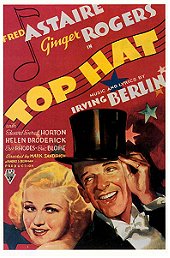Cinema produces many iconic pairings, typically comedic duos who play off each other brilliantly, and find ways to make their disparate qualities part of the material, like Laurel & Hardy or the Marx Brothers. Or similar stars with personas that mesh well, like William Powell and Myrna Loy as the movie’s gold star duo for smart, witty, urbane, sophisticated couples whose characters clearly enjoyed a great sex life and their mental sparring. Then there’s the strange duo of Fred Astaire and Ginger Rogers, a marked study in contrasts that on paper seems all wrong, but once the projection booth starts going becomes positively transcending.
Astaire is smooth as glass while dancing; no he glides, yes, he glides across the screen. His entire body continuing and elongating his fluid movements, typically dressed in a tuxedo and doing much of his best work solo. He also wasn’t the handsomest song-and-dance man around, looking a little bit bulgy eyed and projecting an air of sexlessness. Ginger Rogers, by contrast, was an earthy pistol, a gum-chewing chorus girl who made good. Her career trajectory during the 30s and 40s was not unlike any of her numerous parts in films like 42nd Street or Stage Door. She was brassy, and a competent dancer, but nowhere near the expert technique of Rita Hayworth or Cyd Charisse. Yet together they’re one of the most romantic, magical pairings in the history of cinema.
They made nine films together, effectively launching his career with Flying Down to Rio in 1933 and pushing her towards the top of RKO’s star roster. But Astaire, having come up as part of a duo with his sister Adele, hesitated to engage in the partnership, only coming around once he noticed that his career prospects would only improve if he teamed up with Rogers. This backstage drama is nowhere to be found in any of their films together, of which Top Hat is the fourth, the most well known, most financially successful, and the quintessential. Many would argue that Swing Time is better, and in many respects, it is, but Top Hat is the ne plus ultra of their pairings.
Everything here works, including the plot's easygoing machinations. No one goes into an Astaire-Rogers film looking for narrative complexity and depth, and this one is smart enough to tackle the situation of mistaken identity with a screwball verve. Outside of her films with Astaire, Rogers was a gifted performer with a way with a wry one-liner, a withering look, and an unflappable demeanor. So many of the heavy-lifting moments are handed to her while Astaire gets the lion’s share of complicated dance routines. They even each other out, he covering for her weaknesses as a dancer, and she making their romance’s ups and downs believable.
Yet the two most memorable moments in the film are their shared dance routines. “Isn’t This a Lovely Day (to be Caught in the Rain)” communicates a softening of her resolve to him, at first antagonistic to him, as he sings to her back we can see her quicksilver thoughts and changing emotions. Once they begin to dance, forget it, this is the magical stuff that we go to the movies for. The dancing changes throughout, first with Rogers mocking Astaire, then they engage in a playful duel, before finally working together. Their ebullience is potent.
Greater still is “Cheek to Cheek,” the consummation of their romance. There’s no athletic, flirtatious choreography here as in “Isn’t it a Lovely Day,” just a quiet, delicate passionate entanglement between the two. Rogers wears the infamous feathered gown that makes her twirls, bends, and fluid movements seem ever continuing. Her dress provides a visual underline to the movements, culminating in a deep backbend that looks positively dreamy. Out of all the various dance sequences in the Astaire-Rogers films, “Cheek to Cheek” is probably the most famous having appeared in The Purple Rose of Cairo and The Green Mile, to name just two of the major ones.
Top Hat is perfection, the type of escapism that is utterly charming in its simplistic structure. Much like later day musical sensations like Esther Williams or Mickey Rooney, all of their films follow a basic series of events, types of dances, and supporting players. What makes Top Hat such a definitive example of the Astaire-Rogers films is how effortless it all appears, how much energy it projects, the strength of the Irving Berlin songs, and a dreamy, tender world unlike any other before or since. Sometimes it’s nice to escape into this Art Deco wonderland, where the idle rich engage in oblique games of love, and where heaven looks an awful lot like two people dancing cheek to cheek.
 Login
Login